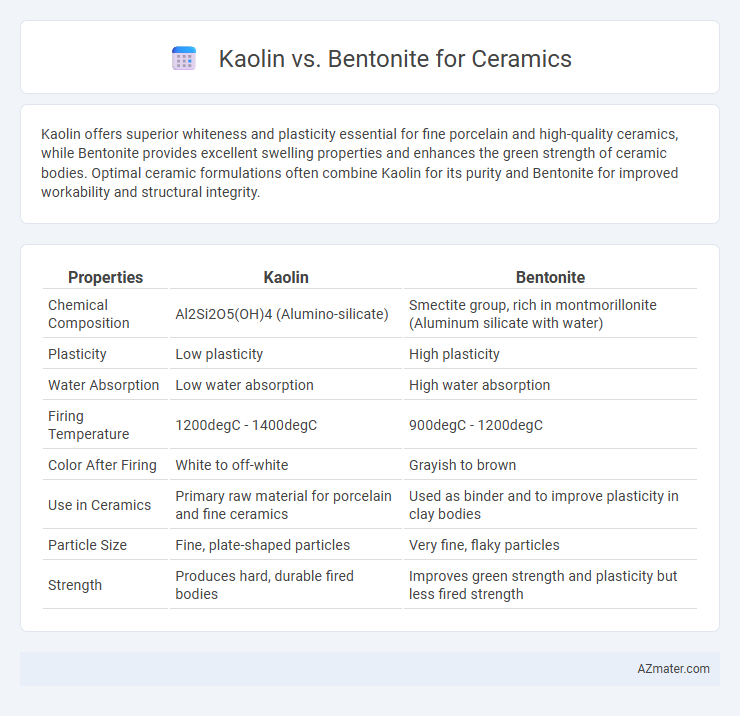Kaolin offers superior whiteness and plasticity essential for fine porcelain and high-quality ceramics, while Bentonite provides excellent swelling properties and enhances the green strength of ceramic bodies. Optimal ceramic formulations often combine Kaolin for its purity and Bentonite for improved workability and structural integrity.
Table of Comparison
| Properties | Kaolin | Bentonite |
|---|---|---|
| Chemical Composition | Al2Si2O5(OH)4 (Alumino-silicate) | Smectite group, rich in montmorillonite (Aluminum silicate with water) |
| Plasticity | Low plasticity | High plasticity |
| Water Absorption | Low water absorption | High water absorption |
| Firing Temperature | 1200degC - 1400degC | 900degC - 1200degC |
| Color After Firing | White to off-white | Grayish to brown |
| Use in Ceramics | Primary raw material for porcelain and fine ceramics | Used as binder and to improve plasticity in clay bodies |
| Particle Size | Fine, plate-shaped particles | Very fine, flaky particles |
| Strength | Produces hard, durable fired bodies | Improves green strength and plasticity but less fired strength |
Introduction to Kaolin and Bentonite
Kaolin and bentonite are essential clay minerals widely used in ceramics for their unique properties. Kaolin, a white, fine-grained clay rich in kaolinite, provides excellent plasticity and whiteness, making it ideal for porcelain and fine china production. Bentonite, composed mainly of montmorillonite, offers superior swelling and binding capabilities, enhancing ceramic body strength and moisture retention.
Chemical Composition Differences
Kaolin and bentonite differ primarily in their chemical composition, which influences their performance in ceramics. Kaolin is predominantly composed of the mineral kaolinite, with the chemical formula Al2Si2O5(OH)4, characterized by a high alumina (Al2O3) content and lower silica (SiO2) ratio, contributing to its white firing properties and plasticity. Bentonite mainly consists of montmorillonite, a smectite clay rich in silica, alumina, and magnesium, with a layered structure that enhances water absorption and swelling, affecting the ceramic body's plasticity and drying behavior.
Physical Properties Comparison
Kaolin exhibits a fine particle size with high purity and low plasticity, offering excellent whiteness and a smooth texture ideal for ceramic bodies. Bentonite features a higher plasticity and swelling capacity due to its montmorillonite content, improving workability and green strength but increasing shrinkage during drying. The distinct physical properties influence ceramic processing efficiency, with kaolin preferred for whiteware and bentonite favored for applications requiring enhanced plasticity and binding.
Role in Ceramic Production
Kaolin serves as a primary source of alumina and silica, providing essential plasticity and whiteness to ceramic bodies, which enhances the strength and durability of the fired products. Bentonite contributes superior plasticity and binding properties due to its high swelling capacity, improving the workability and structural integrity during forming processes. Together, kaolin and bentonite balance ceramic composition by optimizing particle size distribution and mineralogical properties crucial for shaping, drying, and firing performance.
Plasticity and Workability
Kaolin exhibits lower plasticity compared to bentonite, resulting in less flexible but smoother ceramic bodies, which enhances surface finish quality. Bentonite's high plasticity improves workability by increasing the clay's ability to retain water and maintain shape during molding and shaping processes. The choice between kaolin and bentonite significantly influences the ceramic's firmness and ease of manipulation, with bentonite preferred for complex forms and kaolin favored for refined textures.
Firing Behavior and Temperature Suitability
Kaolin and bentonite exhibit distinct firing behaviors crucial for ceramic production, with kaolin demonstrating superior thermal stability and whiteness at high temperatures up to 1400degC, making it ideal for porcelain and fine ceramics. Bentonite, containing higher montmorillonite content, enhances plasticity but has a lower firing temperature threshold around 1100-1200degC, which may cause darkening or deformation if overheated. Selecting kaolin over bentonite improves resistance to thermal shock and aids in achieving a vitrified, durable ceramic body suited for high-temperature applications.
Impact on Final Ceramic Color
Kaolin imparts a bright white color to ceramics due to its high purity and low iron content, making it ideal for porcelain and fine whiteware. Bentonite, containing higher iron and impurities, often results in a grayish or off-white final color, affecting the aesthetic quality of the ceramic piece. The choice between kaolin and bentonite significantly influences the whiteness and brightness of the finished ceramic product.
Pros and Cons of Using Kaolin
Kaolin offers excellent plasticity and white firing properties, making it ideal for fine ceramics and porcelain due to its high purity and low iron content, which enhances brightness and strength. However, Kaolin's lower swelling capacity compared to Bentonite limits its use in applications requiring high water absorption or binding properties. Its cost is generally higher than Bentonite, making it less suitable for bulk or cheaper ceramic products where durability and plasticity are less critical.
Pros and Cons of Using Bentonite
Bentonite offers excellent plasticity and improved binding properties, making it ideal for shaping and molding ceramics with high green strength. However, its high shrinkage rate and potential for introducing impurities can cause cracking and weaken the final ceramic product compared to kaolin. Despite these challenges, bentonite's ability to enhance workability and reduce drying time remains valuable in ceramic production.
Choosing the Right Clay for Your Ceramic Project
Kaolin offers high purity and whiteness, making it ideal for porcelain and fine ceramic projects requiring smooth texture and translucency. Bentonite provides excellent plasticity and water retention, enhancing workability and shaping in pottery and ceramics that demand flexibility during molding. Selecting the right clay depends on the ceramic project's specific needs for strength, texture, and firing temperature, with kaolin preferred for whiteware and bentonite for improved plasticity and bonding.

Infographic: Kaolin vs Bentonite for Ceramic
 azmater.com
azmater.com